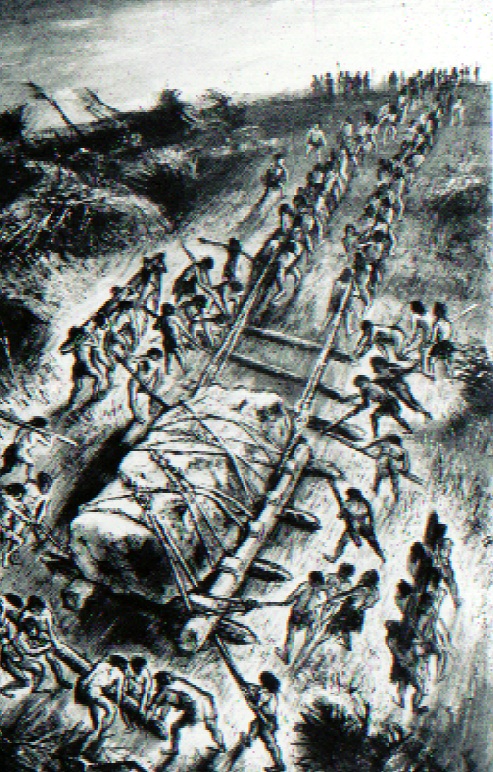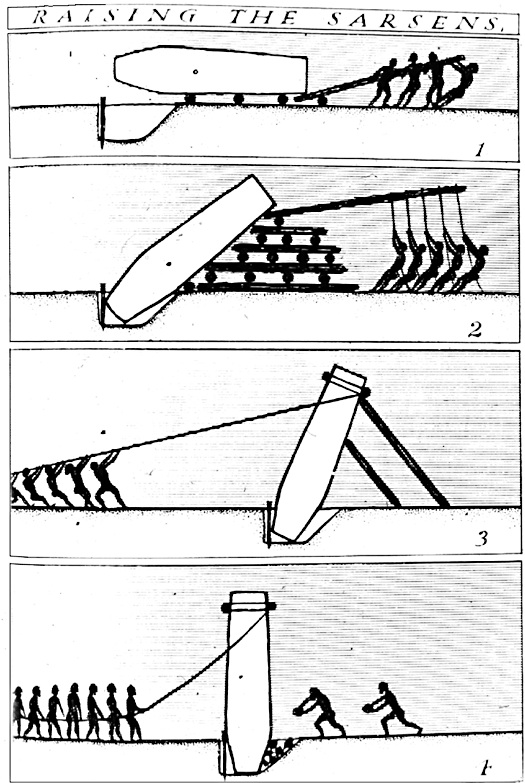Tracking the Migration of Sunset
Well, there we are. We know what doesn’t work. It may be discouraging, but scientists who have an idea usually keep trying until they have exhausted every possibility.
Optional: If you have time, you can call for other suggestions and try them now, like the Moon in different phases, or the planets.We have considered alignments on today’s date, about 3500 years ago.
Would changing the date by a week or a month make any difference in where things rise or set?
Let’s find out if the Sun will set in a different place on a different day from today.
Which marker shows where it set last night? Which shows where it rose today? [Ask students to remove all other markers.]
Now let’s try next week.
I will run quickly through the day, but as I do I will also advance the date to one week (one month) from today.
DIGITAL EFFECT: Go +1 Week Crossfade the scene to skip ahead 7 days to approximately one hour before sunrise. Use a sidereal jump command, so the function may be used repeatedly, as time and interest allows. If necessary, clear suntrails, and then turn back on to track the sun’s path. Note: You may make a larger jump into the future, i.e. 30 days instead of 7. DIGITAL EFFECT: Go to Sunrise Run diurnal motion past sunrise until the disc of the Sun is just above the horizon for marking by the audience. During the above effects, you can take a vote as follows:
Let’s take a vote. How many think the Sun will set in the same place next week as it did today? How many think it will set farther to the south? To the north?
[Count and summarize vote.]
DIGITAL EFFECT: Go to Noon Run diurnal motion forward to noon. Upon pausing here, the audience may predict where the Sun will set.
We are close to sunset. Will someone please mark the position of the Sun when it sets? The date is now one month (one week) later.
DIGITAL EFFECT: Go to Sunset Run diurnal motion until just before sunset, so that the disc of the Sun is right above the horizon for marking by the audience. The audience may mark the sunset position.
Who made the best prediction?
Note the direction the sunset position moved, north or south, on today’s date.
Now let’s see if that sunset is marked by Stonehenge.
DIGITAL EFFECT: Stonehenge Panorama and Trilithons Fade on the symbolic Stonehenge panorama and trilithons, as viewed from the center of Stonehenge, to check if the Sun’s rising and setting matches any of the four alignments.
Too bad—we still don’t have it. Of course, the day we just tried is just [repeat date you used].
Fade off the Stonehenge Panorama, Trilithons, and the Sun path.
Is there anything special about that date? Can anyone suggest a date that is special in some astronomical way every year?
Note: If time allows, users may repeat this sequence by jumping another week into the future as many times as they wish. Alternatively (or additionally) users may skip one month at a time. Repeat as often as desired.
Get list of dates and repeat at the end. Included will generally be the holidays, birthdays, and shortest and longest days of the year. The latter two will generally be on the list, but include these yourself if nobody else does.
Which date from our list shall we try?
DIGITAL EFFECT (optional): Try Dates… If time permits, try as many dates as possible, in the order they will come up as you advance annual motion. Between each date, turn the Sun off and stars off, and advance annual motion until you are at the next date you wish to try. Run daily motion until you are just before sunrise before turning the sun on. Let visitors mark sunrise and sunset positions. Point out the migration of the positions to the north or the south, depending on the season in which you started. Eventually you arrive at the next solstice. Adjust the order of seasons below according to your particular starting dates. The following assumes you started between June 21, and December, and are approaching winter. If you started January to May, make appropriate changes.
DIGITAL EFFECT: Winter to Summer Crossfade the scene to sunrise, with half the disc of the Sun above the horizon on the winter solstice date, -1500/01/02. Due to precession and calendrical drift, solstices do not correspond to June 21 and December 21. “Winter Solstice” text is also placed on the dome.
Happy holidays. Here we are at winter solstice, just before sunrise.
Please remove all the markers, and we will start fresh by marking where the Sun rises on this date, the morning before the shortest day of the year.
Today is the day called the “winter solstice” and it varies slightly on the calendar.
Will whoever is closest please place your marker to indicate the position of sunrise?
Notice how far to the south the Sun is rising. Indeed, this is the farthest south the Sun will ever rise as seen from this place on Earth. From today on, the Sun will begin rising back toward the north, farther every day.
DIGITAL EFFECT: Winter Sunset. Run diurnal motion until just before sunset, so the disc of the Sun is right above the horizon for marking by the audience.
You may have noticed that the sun did not get very high in the sky at any time today. It is also up for a much shorter time than it has been on other days. Indeed, this is the most southerly rising, most southerly path, briefest journey of the Sun all year. And that is why this is officially the start of winter! The northern hemisphere receives less energy from the Sun today than it will any other day of the year.
It is interesting to note all the things that happen around winter solstice. Christmas occurs around then, and so do Chanukah and New Year’s Day, and numerous other religious and secular special days. Apparently many peoples have noted the extreme position of the Sun, the brief hours of sunlight on this day. Perhaps they wished to urge the Sun to come back north, eventually bringing longer days and warmer weather. By the way, our calendar does not track the Sun perfectly so some years the shortest day happens to be December 20 or December 22.
It is now sunset on the winter solstice, the shortest day of the year. Let’s mark the position of sunrise on this special day.
Will whoever is closest please place your marker to indicate the spot?
Shall we test our most recent hypothesis, that sunrise and sunset on astronomically significant days might be marked by Stonehenge’s alignments?
DIGITAL EFFECT: Stonehenge Panorama and Trilithons. Fade on the symbolic Stonehenge panorama and trilithons, as viewed from the center of Stonehenge, to confirm the alignment of the Sun’s rising and setting position on the winter solstice date.
Congratulations! Now we have learned that these stones could be used to mark the shortest day of the year by indicating the positions of sunrise and sunset on that one day.
Now that we have found the significance of two of the special alignments which Gerald Hawkins identified, would anyone like to suggest what we should do to find the other two major alignments? Any other dates on our list you want to try?
Fade off the Stonehenge Panorama, Trilithons, and Suntrail. A good technique is to wait for several suggestions and vote to decide what to do. Since the longest day is now the most logical candidate, it is very rare that this will not work. DIGITAL EFFECT: Sun Migration. Run time forward incrementally in explicit one week jumps to sunset on each increment. Run this until the summer solstice on -1500/07/09 at a rate of 1 week per second over 27 seconds. Do this so that it appears the Sun drifts (or migrates) along the horizon. Upon arriving at -1500/07/09 pre-dawn, make the text “Summer Solstice” appear on the dome.
Optional Section If you have time in the program while waiting for the projection to advance to the next solstice, this section treats a question of general interest. How was Stonehenge built? No one knows for sure, but archaeologists have pieced together a plausible version of how Stonehenge was built. These are artists’ conceptions, and, of course, we don’t really know how the builders of Stonehenge were dressed.
VISUAL 15 (still): Sketch of How a Large Stone Might Have Been Transported Fade on image of how a large stone might have been transported.We do know a little about the builders of Stonehenge. The first parts of Stonehenge were built about 2800 BC, 4800 years ago, by “neolithic” (new stone age) farmer/herders. Over the centuries these original people assimilated with the “Beaker People,” so-called because they made distinctive clay beakers for drinking, and these people continued building at Stonehenge. The final stages, including the giant trilithons, were built about 1550 BC, nearly 3500 years ago, by the Wessex people, descendants of the earlier cultures.

None of the builders of Stonehenge had wheels or horses, so they faced a formidable task in moving the giant stones by hand from the nearest quarry, 40 kilometers (25 miles) away. This theory about how they did it involves dragging the stones, by teams of perhaps one hundred men, over the ground by rolling the stones on logs. Note that the stone they are dragging is not finished to the smooth, flat surfaces that most of the biggest stones have. Boulders don’t come in nice rectangular shapes, so after the stones reached the site, they had to be literally pounded into shape. Since the workers didn’t have metal tools, they shaped the huge stones by chipping off chunks with other stones. Some of the smaller stones (a few tons each) came from a quarry ten times farther away. These could have been brought most of the way on rafts.
VISUAL 16 (still): Sketch of a How a Large Stone Might Have Been Set Upright Fade on image of how a large stone might have been set upright. This is an illustration about how the stones were raised. First, a pit was dug, with one slanted side. Notice the reinforcement wooden stakes on the opposite side—remnants of these have actually been found. The stone was then levered into position by building up the lever pivot in stages. No matter how it was done, this was a formidable task that could not have been done in a few years or even a few decades. Archaeologists have established that the building of Stonehenge took place in a number of stages, spanning many generations. People worked on Stonehenge for over 1000 years. Can you think of any projects in modern times that are likely to last so long?DIGITAL EFFECT: End Building Fade off both dragging and raising images. [END OPTIONAL SECTION}

We have now arrived on the Summer Solstice, the longest day of the year.
Will whoever is closest please mark the point when the Sun is just half way up?
DIGITAL EFFECT: Summer Sunset. Run diurnal motion until just before sunset, so the disc of the Sun is right above the horizon for marking by the audience. After marking, turn on diurnal and continue to sunset. During the minute or so necessary for the above effect, you can invite questions or summarize proceedings so far.
This is the first day of summer, the longest day of the year. In contrast to winter solstice, notice how far north the Sun rose, how high in the sky it gets, and how long the path will be, giving us a long, hot day.

